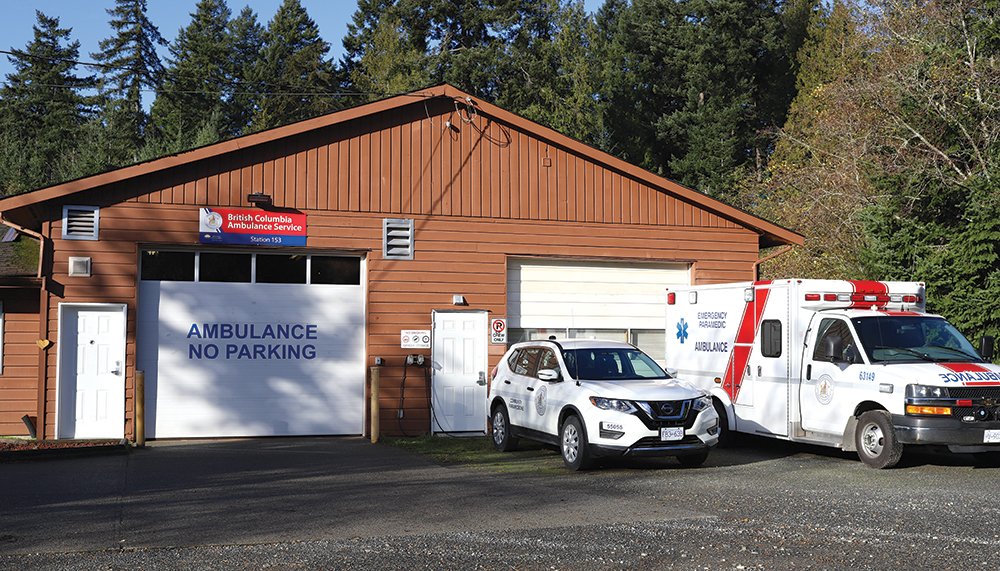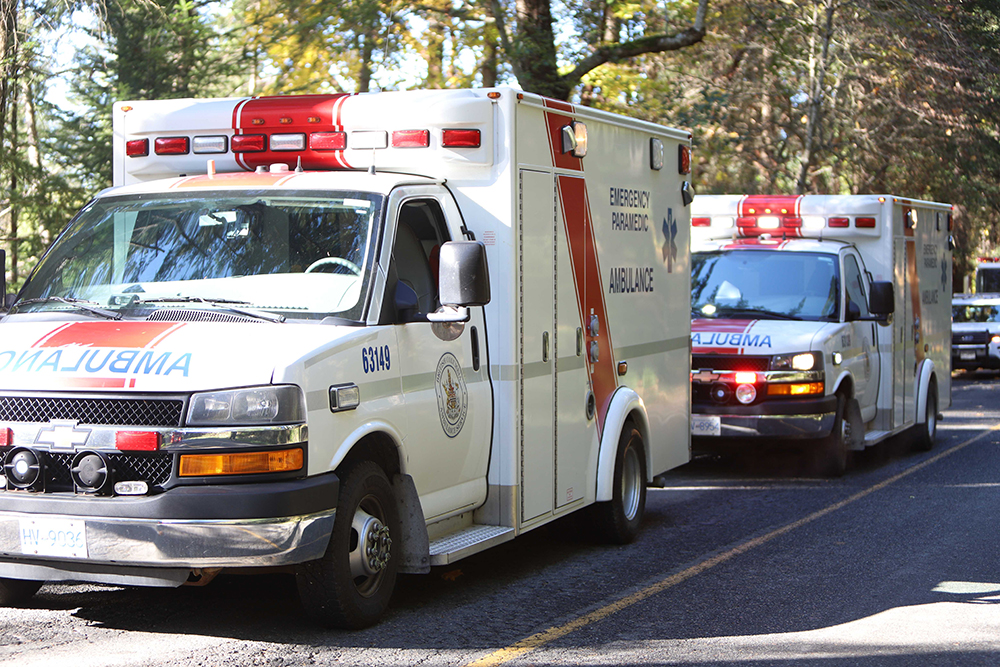The ambulances on Gabriola Island. BC EHS has announced the Gabriola station will be moving the primary ambulance to an Alpha shift pattern, with paramedics staying at the station 24/7, responding within 90 seconds if called. The second ambulance will be kept on Gabriola and staffed with the Kilo (on-call) model. Sounder file photos.
Sounder News
Gabriola is one of 21 communities where ambulance stations in BC are moving to a full-time Alpha style shift pattern.
This will see staff staying at the station 24/7, to ensure a 90-second response time to residents. The exact date of when the shift pattern will change has not been announced.
Media representatives for BC Emergency Health Services (BC EHS) confirmed the second ambulance assigned to the Gabriola station will be kept operating on the ‘Kilo’ model. Kilo staff operate on pager and respond to the station if they are required.
In 2021, the Gabriola station moved to the existing Scheduled On-Call (SOC) model. This sees SOC members scheduled for three 24-hour periods in a row, and then have three 24-hour periods off. The crews are paid their full wage to be at station between 8am and 4pm, and are on pager for the other 16 hours of their shift.
The provincial government has accepted recommendations brought forward by BC EHS and the Ambulance Paramedics and Ambulance Dispatchers of BC (APADBC), about the phasing out of the existing Scheduled On-call (SOC) staffing model.
There are 60 SOC stations in BC. Each of those stations is moving to one of three models based on community need.
21 communities, including Gabriola, will move to an “alpha” 24/7 model, which will provide more reliable 24/7 emergency response service.
25 communities will move to a “mix shift” model, which will provide staff with more flexibility and better work/life balance.
14 communities will move to the “kilo” model with a full-time permanent unit chief, which will offer more flexible staffing options to maximize local recruitment. Jason Jackson, Ambulance Paramedics of BC president said, “Paramedics play a major role in small-town healthcare. With this announcement, thanks to our continuing collaborative approach to improving deployment and staffing, we will see a renewed commitment to providing many new full-time resources to dozens of communities across B.C.
“This is a fundamental change in how we provide paramedic services in these communities and will address how we respond to 911 calls, how we recruit and retain paramedics to work in smaller communities, and most importantly, how we can provide better care to our patients.”
Adrian Dix, Minister of Health said, “today’s announcement by BCEHS is an important step toward providing more equitable access to care for people living in rural and remote communities, and better compensation and work environments for paramedics. I commend the collaboration by BCEHS and CUPE 873 to make things better for paramedics who provide valuable, essential healthcare service to people in B.C.”
BC EHS stated in their press release that the changes were not only brought forward by the union and government but also through consultation with local paramedic staff, health-care partners and community members. BC EHS and APADBC have worked closely together to determine the best staffing model for each of the 60 communities and to bring forward recommendations to the Ministry of Health.
BC EHS stated that through the new models:
• BCEHS will be available to support routine transfers in the late afternoon and evenings as needed.
• Paramedics will no longer need to work for 72 straight hours, as required in the SOC model.
• Paramedics will have a better work/life balance, which means that BCEHS will be better able to ensure all communities are covered, especially in the evenings.
The success of this transformation throughout rural and remote BC leverages the new ratified collective agreement, which also increased the on-call (pager) rate of pay from $2 per hour to $12 per hour. This will continue to benefit those members who staff the Kilo car at the Gabriola station.
Jennifer Rice, Parliamentary Secretary for Rural Health said, “Everyone deserves to get reliable access to care, no matter where they live.
“This announcement will go a long way in supporting rural and remote communities and will help ensure more equitable access to health care.”
Leanne Heppell, BCEHS’ Chief Ambulance Officer said, “We are excited to be bringing these staffing model improvements to our paramedics and the rural and remote communities we serve.
“We recognize that one staffing model doesn’t work for all parts of the province, and these three models will help us improve our services to better meet the needs of the community and patients and enable more of our paramedics to live and work in their home communities.”






Recent Comments